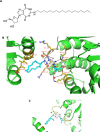NZ51, a ring-expanded nucleoside analog, inhibits motility and viability of breast cancer cells by targeting the RNA helicase DDX3
- PMID: 26337079
- PMCID: PMC4745771
- DOI: 10.18632/oncotarget.4898
NZ51, a ring-expanded nucleoside analog, inhibits motility and viability of breast cancer cells by targeting the RNA helicase DDX3
Abstract
DDX3X (DDX3), a human RNA helicase, is over expressed in multiple breast cancer cell lines and its expression levels are directly correlated to cellular aggressiveness. NZ51, a ring-expanded nucleoside analogue (REN) has been reported to inhibit the ATP dependent helicase activity of DDX3. Molecular modeling of NZ51 binding to DDX3 indicated that the 5:7-fused imidazodiazepine ring of NZ51 was incorporated into the ATP binding pocket of DDX3. In this study, we investigated the anticancer properties of NZ51 in MCF-7 and MDA-MB-231 breast cancer cell lines. NZ51 treatment decreased cellular motility and cell viability of MCF-7 and MDA-MB-231 cells with IC50 values in the low micromolar range. Biological knockdown of DDX3 in MCF-7 and MDA-MB-231 cells resulted in decreased proliferation rates and reduced clonogenicity. In addition, NZ51 was effective in killing breast cancer cells under hypoxic conditions with the same potency as observed during normoxia. Mechanistic studies indicated that NZ51 did not cause DDX3 degradation, but greatly diminished its functionality. Moreover, in vivo experiments demonstrated that DDX3 knockdown by shRNA resulted in reduced tumor volume and metastasis without altering tumor vascular volume or permeability-surface area. In initial in vivo experiments, NZ51 treatment did not significantly reduce tumor volume. Further studies are needed to optimize drug formulation, dose and delivery. Continuing work will determine the in vitro-in vivo correlation of NZ51 activity and its utility in a clinical setting.
Keywords: RNA helicase DDX3; ring-expanded nucleoside.
Conflict of interest statement
The authors report no conflict of interest.
Figures






Similar articles
-
Identification of the DEAD box RNA helicase DDX3 as a therapeutic target in colorectal cancer.Oncotarget. 2015 Sep 29;6(29):28312-26. doi: 10.18632/oncotarget.4873. Oncotarget. 2015. PMID: 26311743 Free PMC article.
-
RK-33 Radiosensitizes Prostate Cancer Cells by Blocking the RNA Helicase DDX3.Cancer Res. 2016 Nov 1;76(21):6340-6350. doi: 10.1158/0008-5472.CAN-16-0440. Epub 2016 Sep 12. Cancer Res. 2016. PMID: 27634756 Free PMC article.
-
Targeting RNA helicase DDX3X with a small molecule inhibitor for breast cancer bone metastasis treatment.Cancer Lett. 2024 Nov 1;604:217260. doi: 10.1016/j.canlet.2024.217260. Epub 2024 Sep 19. Cancer Lett. 2024. PMID: 39306228
-
DEAD-box RNA Helicase DDX3: Functional Properties and Development of DDX3 Inhibitors as Antiviral and Anticancer Drugs.Molecules. 2020 Feb 24;25(4):1015. doi: 10.3390/molecules25041015. Molecules. 2020. PMID: 32102413 Free PMC article. Review.
-
A double-edged function of DDX3, as an oncogene or tumor suppressor, in cancer progression (Review).Oncol Rep. 2018 Mar;39(3):883-892. doi: 10.3892/or.2018.6203. Epub 2018 Jan 9. Oncol Rep. 2018. PMID: 29328432 Review.
Cited by
-
The DEAD-box protein family of RNA helicases: sentinels for a myriad of cellular functions with emerging roles in tumorigenesis.Int J Clin Oncol. 2021 May;26(5):795-825. doi: 10.1007/s10147-021-01892-1. Epub 2021 Mar 3. Int J Clin Oncol. 2021. PMID: 33656655 Review.
-
Global Effects of DDX3 Inhibition on Cell Cycle Regulation Identified by a Combined Phosphoproteomics and Single Cell Tracking Approach.Transl Oncol. 2018 Jun;11(3):755-763. doi: 10.1016/j.tranon.2018.04.001. Epub 2018 Apr 24. Transl Oncol. 2018. PMID: 29684792 Free PMC article.
-
DEAD-Box RNA Helicases in Cell Cycle Control and Clinical Therapy.Cells. 2021 Jun 18;10(6):1540. doi: 10.3390/cells10061540. Cells. 2021. PMID: 34207140 Free PMC article. Review.
-
Down-regulation of C35 decreased the cell viability and migration of breast ductal carcinoma cells.PLoS One. 2017 Aug 31;12(8):e0183941. doi: 10.1371/journal.pone.0183941. eCollection 2017. PLoS One. 2017. PMID: 28859163 Free PMC article.
-
DDX3 localizes to the centrosome and prevents multipolar mitosis by epigenetically and translationally modulating p53 expression.Sci Rep. 2017 Aug 25;7(1):9411. doi: 10.1038/s41598-017-09779-w. Sci Rep. 2017. PMID: 28842590 Free PMC article.
References
-
- NCI A Snapshot of Breast Cancer. Cancer Snapshots: Disease Focused and Other Snapshots. 2013
-
- Afifi M. Risk factors of breast cancer in women in Kelantan, Malaysia. Singapore Med J. 2006;47:551. author reply 552–553. - PubMed
-
- Salih AK, Fentiman IS. Breast cancer prevention: present and future. Cancer Treat Rev. 2001;27:261–273. - PubMed
-
- Lodovici M, Luceri C, Guglielmi F, Bacci CA, Victor F, Maria L, et al. Benzo(a)pyrene Diolepoxide (BPDE)-DNA Adduct Levels in Leukocytes of Smokers in Relation to Polymorphism of CYP1A1, GSTM1, GSTP1, GSTT1, and mEH. Cancer Epidemiol Biomarkers Prev. 2004;13:1342–1348. - PubMed
Publication types
MeSH terms
Substances
LinkOut - more resources
Full Text Sources
Other Literature Sources
Medical
Miscellaneous

